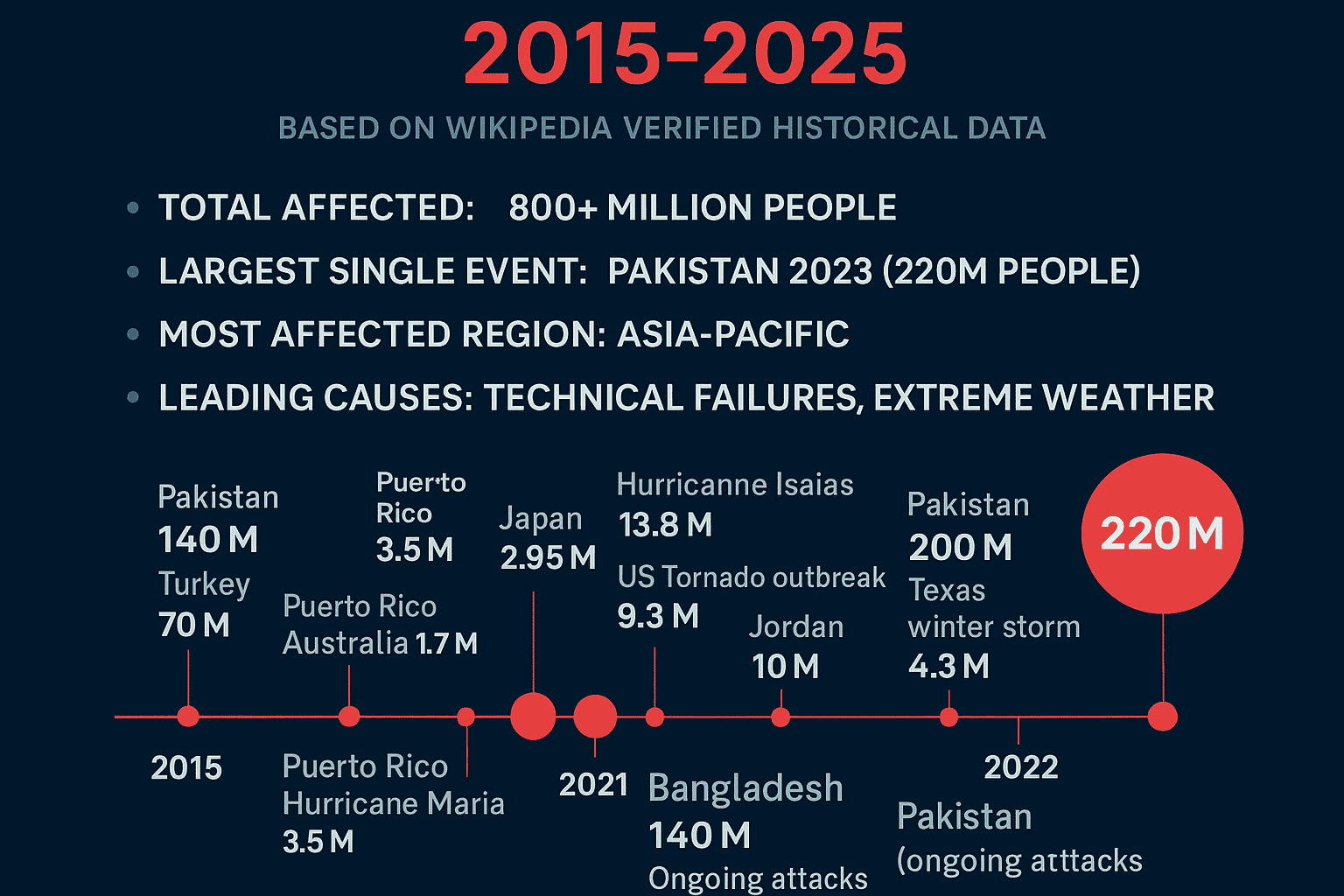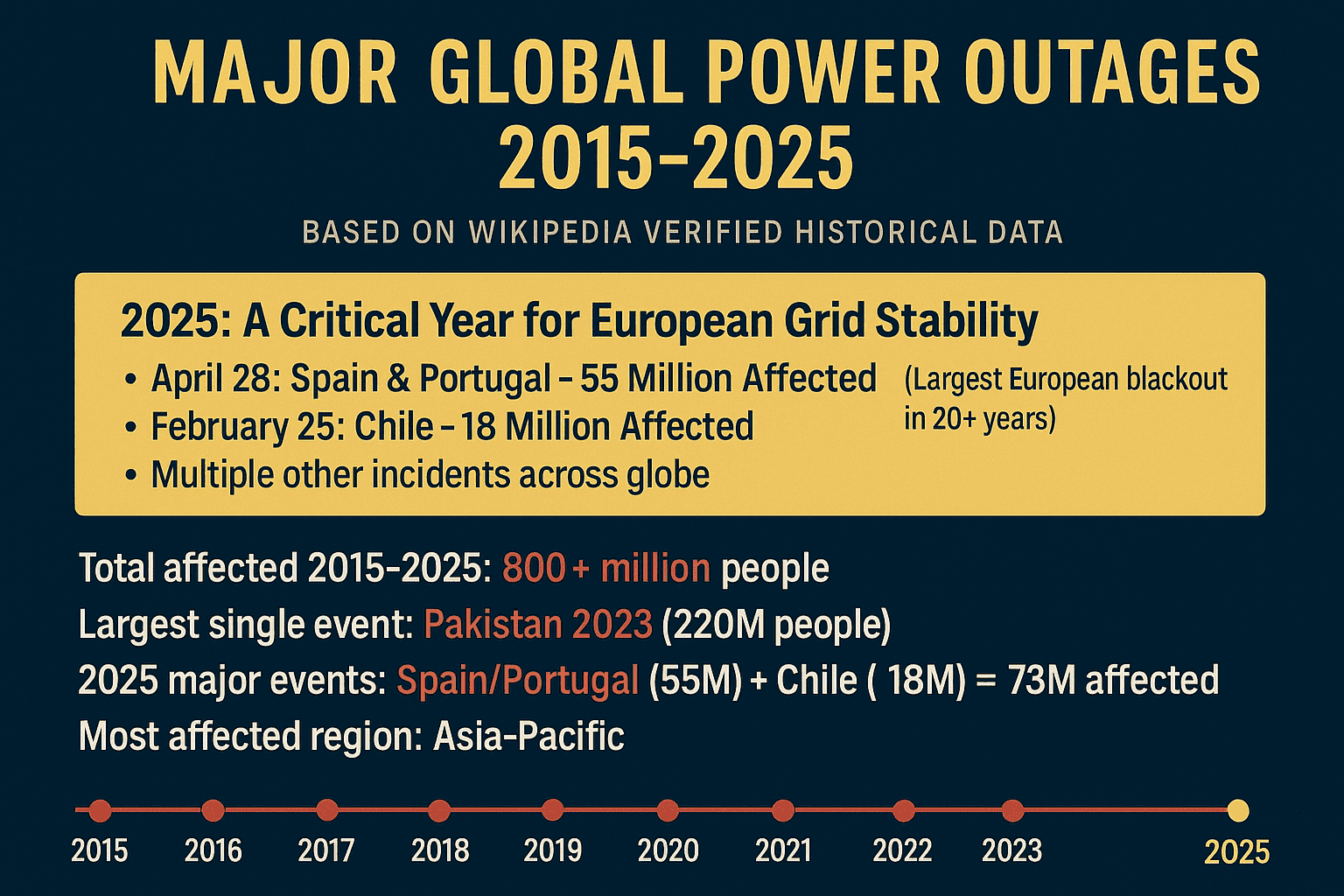The Growing Global Demand for Power Stations in an Age of Outages
Understanding the surge in electrical disruptions and how portable power stations provide reliable backup solutions for homes and businesses worldwide
Affiliate Disclosure: This page contains affiliate links. If you click through and make a purchase, we may earn a commission at no additional cost to you.
The Alarming Rise in European and Global Power Outages
A Decade of Growing Grid Instability
Global power outages have escalated dramatically over the past decade. According to verified data from Wikipedia (2015-2025), these disruptions have affected over 800 million people worldwide. Moreover, 2025 has marked a critical turning point in grid reliability.
On April 28, 2025, Europe experienced its largest blackout in over 20 years. Specifically, 55 million people across Spain and Portugal lost power simultaneously. Shortly after, Chile faced a nationwide outage that affected 18 million people. Consequently, these incidents demonstrate that even the world’s most advanced electrical grids face increasing vulnerability.
As a result, portable power stations have become essential backup solutions. In fact, they now serve as critical infrastructure for homes and businesses navigating this new era of grid instability.
Sources: Wikipedia: List of major power outages, ENTSO-E, IEA Electricity 2023, Reuters, BBC, The Guardian, Euronews, Red Eléctrica Española, Al Jazeera, X posts. Data analysis by Power Station HQ.
Europe’s Grid Challenges: A Continent Under Strain
Europe’s interconnected power grids face mounting challenges. Managed by ENTSO-E across 27 countries, these grids experience increasing disruptions. Furthermore, climate-driven weather events now occur with greater frequency. Additionally, renewable energy variability and aging infrastructure compound these issues.
The System Average Interruption Duration Index (SAIDI) averaged 70–150 minutes per customer in 2024. However, reliability varies significantly by country. For instance, Germany achieves high reliability with approximately 15 minutes of outages annually. In contrast, Romania faces considerably longer disruptions, averaging around 200 minutes per year.

Global outages have affected over 800 million people from 2015 to 2025. Additionally, major events like the 2025 Iberian and Chile blackouts highlight grid vulnerabilities worldwide.
Major European Power Outages: Recent Disruptions
The 2025 Crisis Year
2025 has proven to be a watershed year for European grid stability. Throughout the year, multiple countries experienced significant blackouts. Consequently, millions of residents and businesses faced extended periods without power.
Critical European Incidents (2024–2025):
- Iberian Peninsula (April 28, 2025): Approximately 55 million people were affected for roughly 10 hours. This massive blackout stretched across Spain, Portugal, and parts of southwest France. It was caused by a cascade of technical failures. Specifically, Spain experienced a sudden loss of generation. Additionally, a key interconnector with France failed simultaneously. As a result, the outage disrupted transportation, communications, and emergency services. Tragically, approximately 8 fatalities were linked to generator-related incidents and fires.
- Italy (July 1, 2025): Around 500,000 people were affected for several hours. Heatwave-induced outages struck Bergamo, Florence, and Milan-area cities. These included Sesto San Giovanni and Cinisello Balsamo. The disruptions occurred due to overheated power lines. Furthermore, high air conditioning demand exacerbated the problem.
- Italy (April 28, 2025): Parts of Italy experienced minor impact with brief duration. Specifically, these areas were briefly affected by the Iberian Peninsula blackout’s grid disturbance.
- United Kingdom (Late January/Early February 2025): Approximately 1 million people were affected for more than 24 hours. Storm Éowyn’s 90+ mph winds caused widespread outages. These stretched across England, Wales, and Northern Ireland. In some areas, restoration required over a day to complete.
- United Kingdom (January 8, 2025): This was a near-miss event. Tight grid margins resulted from low wind and solar output. Additionally, interconnector issues compounded the situation. As a result, emergency measures were required to avoid widespread outages.
- France (April 28, 2025): Southwest France near the Spanish border experienced minor impact with brief duration. This occurred as a result of the Iberian Peninsula blackout’s ripple effects.
- France (May 24, 2025): Approximately 100,000 people were affected for several hours. A major outage struck the Alpes-Maritimes region. Notably, this included the city of Cannes, which experienced significant disruptions.
- Netherlands (May 1, 2025): 20,000 people were affected for approximately 2 hours. A short circuit occurred during maintenance at a distribution station. Consequently, this caused an outage in Enschede.
- Netherlands (March 18, 2025): 45,000 people were affected for several hours. A major outage in The Hague disrupted traffic lights. Additionally, tram services were significantly impacted.
- Germany (2024–2025): No major blackouts were reported during this period. However, concerns were raised about grid stability. This is due to increased energy consumption and lower renewable output. Consequently, reliance on fossil fuels has increased.

Major European outages in 2024–2025 are shown above. These include the Iberian blackout and Italian heatwave disruptions. Therefore, they highlight the growing need for reliable backup power solutions.
United Kingdom: Ongoing Grid Vulnerabilities
The UK’s grid faces persistent challenges. Managed by National Grid ESO, it struggles with extreme weather events. Moreover, infrastructure limitations continue to pose significant risks.
Recent UK Grid Challenges
Several key incidents have highlighted the vulnerability of the UK’s electrical infrastructure. Furthermore, these events demonstrate the need for improved resilience and backup solutions.
- Annual SAIDI (2024): Approximately 40–50 minutes per customer were recorded. This is up from approximately 40 minutes in 2015. Consequently, this reflects increased disruptions over the decade.
- Storm Éowyn (Late January/Early February 2025): Approximately 1 million people were affected for more than 24 hours. Winds exceeded 90 mph, causing widespread outages. These stretched across England, Wales, and Northern Ireland.
- Near-Miss Event (January 8, 2025): Tight grid margins developed due to low renewable output. Additionally, interconnector issues complicated the situation. As a result, emergency measures were required to prevent blackouts.
- Historical Outage (August 9, 2019): 1 million people were affected for 9 hours. A lightning strike near London caused simultaneous failures. Specifically, both a wind farm and gas plant went offline. Consequently, this stranded thousands of commuters.
Understanding the Root Causes
European grids face multiple interconnected challenges. Understanding these factors is essential for developing effective solutions. Moreover, these issues will likely intensify in coming years.
Why European Grids Face Challenges:
- Renewable Energy Integration: Solar and wind variability poses significant challenges. For example, the 2025 Iberian blackout demonstrated this clearly. Without adequate storage, these fluctuations can destabilize entire grids.
- Extreme Weather: Storms like Éowyn cause extensive infrastructure damage. Similarly, heatwaves such as Italy’s 2025 event dramatically increase demand. Consequently, grid operators struggle to maintain balance.
- Interconnected Grids: Failures can cascade across borders rapidly. For instance, Spain’s 2025 outage quickly spread to Portugal and France. Therefore, international cooperation becomes crucial for grid stability.
- Aging Infrastructure: Outdated equipment contributes to frequent failures. This is evident in the Netherlands and UK incidents. As a result, modernization efforts are urgently needed.
Global Power Outage Statistics: Beyond Europe
Worldwide Grid Instability in 2025
Globally, 2025 witnessed significant outages across multiple continents. Spain and Chile experienced the largest impacts. Additionally, numerous other countries faced major disruptions throughout the year.
Major Global Incidents (2025):
- Spain & Portugal (April 28, 2025): Approximately 55 million people were affected for roughly 10 hours. A cascade of technical failures occurred, including generation loss and interconnector failure. Consequently, this caused Europe’s largest blackout in over 20 years.
- Chile (February 25, 2025): Approximately 18 million people were affected for several hours. A transmission line failure caused a nationwide blackout. This impacted 14 of 16 regions, affecting 98% of the population.
- United States (January 8, 2025): An unknown number were affected in ongoing incidents. Specifically, wildfires triggered emergency power shutdowns in Los Angeles.
- Sri Lanka (February 9, 2025): Approximately 22 million people were affected for several hours. A substation issue near Colombo led to a nationwide outage. Reportedly, this was caused by a monkey entering a transformer.
- Panama (March 15, 2025): An unknown number were affected for several hours. A transformer explosion triggered a protection system. As a result, this caused a nationwide blackout.
- Australia (March 7, 2025): 315,000 homes were affected for several days. Cyclone Alfred caused widespread outages in southeast Queensland. Additionally, northern New South Wales was significantly impacted.
- United Kingdom (March 21, 2025): 67,000 homes were affected for most of the day. A transformer fire at a substation disrupted power. Furthermore, it caused flight cancellations at Heathrow, stranding 200,000 passengers.
- Puerto Rico (April 16, 2025): Approximately 3.7 million people were affected for several hours. A territory-wide blackout impacted the entire population.
- Indonesia (May 2, 2025): Approximately 940,000 people were affected for roughly 9 hours. A power outage in Bali was partially restored for half of customers by 7:30 PM. Subsequently, it was fully restored by 1 AM the next day.
Understanding Portable Power Stations: A Defense Against Blackouts
The Evolution of Backup Power
Power grids have become increasingly unreliable in recent years. Consequently, portable power stations have emerged as essential backup solutions. Unlike traditional diesel generators, these battery-powered units offer numerous advantages. Specifically, they provide clean, silent, and maintenance-free emergency power.
What is a Portable Power Station?
A portable power station is a battery-powered device. It stores electrical energy and provides power through various outlets. These include AC, DC, and USB ports. Typically, these units use lithium iron phosphate (LiFePO4) batteries. As a result, they offer superior safety, longevity, and performance compared to traditional alternatives. Moreover, they meet strict safety standards.
Why Portable Power Stations Are Perfect for Homes:
- Silent Operation: There are no noise ordinance violations. In contrast, petrol generators often create noise complaints.
- Zero Emissions: These devices produce no CO2 emissions. Furthermore, they comply with environmental regulations.
- Indoor Safety: They can be used inside homes safely. Unlike gas generators, they don’t require ventilation concerns.
- Grid Integration: Many models offer grid-tie capabilities. Consequently, switching during outages becomes seamless.
- Solar Charging: They are compatible with rooftop solar installations. Therefore, you can maintain power even during extended outages.
- Compact Design: These units are suitable for homes with limited storage space. Additionally, they’re easily portable when needed.
- Smart Features: App connectivity enables remote monitoring. As a result, you can track power usage during outages.
Top 3 Portable Power Stations for Homes
We’ve evaluated numerous models based on safety standards and grid compatibility. Additionally, we considered performance during recent power crises. Therefore, here are our top recommendations:

Anker Solix F3800 – Complete Home Backup Solution
The ultimate home backup system offers whole-house power. Moreover, it features advanced grid integration capabilities. Additionally, it complies with safety standards.
- Capacity: 3,840Wh (expandable to 26.9kWh)
- AC Output: 6,000W (9,000W surge)
- Compatibility: 230V output, CE certified
- Solar Input: 2,400W max (dual MPPT)
- Battery Type: LiFePO4 (3,000+ cycles, 10+ years)
- Grid Integration: Seamless switching during outages
- Smart Features: App control, energy management
Perfect For: Homes requiring complete backup power during extended blackouts. For example, this is ideal for events like the Iberian Peninsula outage. Furthermore, it powers heating systems, refrigeration, and all essential appliances.
View on Amazon →
EcoFlow Delta Pro 3 – Weather-Resistant Powerhouse
IP65-rated protection makes this ideal for harsh weather conditions. Additionally, split-phase capability suits electrical systems perfectly.
- Capacity: 4,096Wh (expandable to 48kWh)
- AC Output: 4,000W (8,000W surge)
- Weather Protection: IP65 rated for outdoor use
- Standards: CE marking, RoHS compliant
- Fast Charging: 70 minutes AC charging
- Solar Integration: 2,600W solar input capacity
- Noise Level: <30dB (library quiet)
Perfect For: Homes in storm-prone areas face frequent weather-related outages. Moreover, businesses require reliable backup power solutions. Furthermore, users need weather-resistant outdoor power capabilities.
View on Amazon →
Bluetti AC500 + B300K – Modular Solution
Modular design allows homeowners to scale their system easily. Specifically, they can match their specific needs and budget. Additionally, it offers excellent solar integration.
- Capacity: 2,765Wh (B300K) to 16,588Wh max
- AC Output: 5,000W (10,000W surge)
- Modular Expansion: Up to 6 B300K batteries
- Solar Efficiency: 3,000W solar input per unit
- Compliance: Full CE certification
- Smart Grid: Grid-tie inverter compatibility
- Longevity: 3,500+ cycles (10+ year lifespan)
Perfect For: Households wanting to start with basic backup power can expand later. Moreover, solar panel owners benefit from its integration. Furthermore, users prioritize modularity and future-proofing.
View on Amazon →Purchase Information: Clicking any “View on Amazon” button may result in us earning a commission. However, this comes at no additional cost to you.
Frequently Asked Questions About Power Outages & Backup Solutions
First, prioritize 230V AC output compatibility and CE certification. Additionally, look for LiFePO4 battery technology for longevity. Moreover, solar charging capability is essential. Furthermore, quiet operation below 35dB is important. Also, app connectivity provides convenience. Finally, ensure sufficient capacity with a minimum of 1,000Wh for basic needs. However, 3,000Wh or more is recommended for comprehensive backup.
Additionally, consider expandable systems and grid-tie capabilities. These enable seamless integration with existing electrical systems.
Embracing Resilience: Securing Your Power Future
Global power grids face mounting challenges from climate change and infrastructure demands. However, portable power stations offer a reliable solution for uninterrupted power. Therefore, investing in a high-quality backup system ensures your home or business remains powered. Consequently, you’ll stay protected during unexpected outages.
Looking for a Power Station? Find Your Perfect Power Solution!
From unexpected outages to remote adventures, portable power stations offer the reliable energy solution you need to keep all your essential devices running.
Find Your Power Station